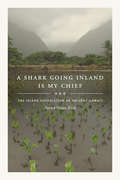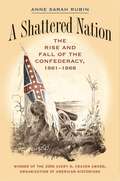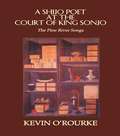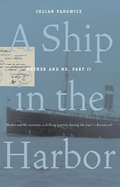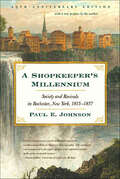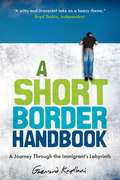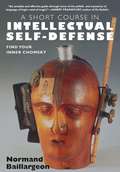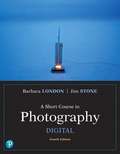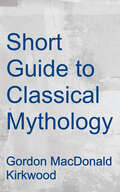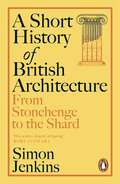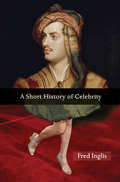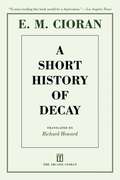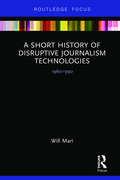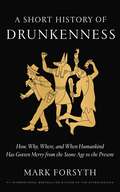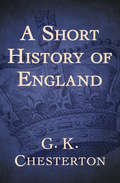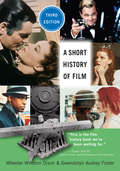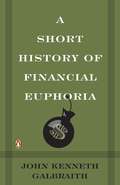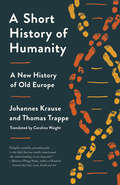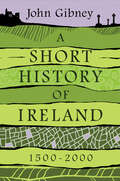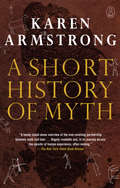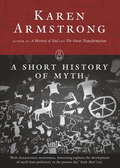- Table View
- List View
A Shark Going Inland Is My Chief: The Island Civilization of Ancient Hawai'i
by Patrick Vinton KirchTracing the origins of the Hawaiians and other Polynesians back to the shores of the South China Sea, archaeologist Patrick Vinton Kirch follows their voyages of discovery across the Pacific in this fascinating history of Hawaiian culture from about one thousand years ago. Combining more than four decades of his own research with Native Hawaiian oral traditions and the evidence of archaeology, Kirch puts a human face on the gradual rise to power of the Hawaiian god-kings, who by the late eighteenth century were locked in a series of wars for ultimate control of the entire archipelago. This lively, accessible chronicle works back from Captain James Cook's encounter with the pristine kingdom in 1778, when the British explorers encountered an island civilization governed by rulers who could not be gazed upon by common people. Interweaving anecdotes from his own widespread travel and extensive archaeological investigations into the broader historical narrative, Kirch shows how the early Polynesian settlers of Hawai'i adapted to this new island landscape and created highly productive agricultural systems.
A Shattered Nation
by Anne Sarah RubinHistorians often assert that Confederate nationalism had its origins in pre-Civil War sectional conflict with the North, reached its apex at the start of the war, and then dropped off quickly after the end of hostilities. Anne Sarah Rubin argues instead that white Southerners did not actually begin to formulate a national identity until it became evident that the Confederacy was destined to fight a lengthy war against the Union. She also demonstrates that an attachment to a symbolic or sentimental Confederacy existed independent of the political Confederacy and was therefore able to persist well after the collapse of the Confederate state. White Southerners redefined symbols and figures of the failed state as emotional touchstones and political rallying points in the struggle to retain local (and racial) control, even as former Confederates took the loyalty oath and applied for pardons in droves.Exploring the creation, maintenance, and transformation of Confederate identity during the tumultuous years of the Civil War and Reconstruction, Rubin sheds new light on the ways in which Confederates felt connected to their national creation and provides a provocative example of what happens when a nation disintegrates and leaves its people behind to forge a new identity.Historians often assert that Confederate nationalism had its origins in pre-Civil War sectional conflict with the North, reached its apex at the start of the war, and then dropped off quickly after the end of hostilities. Anne Sarah Rubin argues instead that white Southerners did not actually begin to formulate a national identity until it became evident that the Confederacy was destined to fight a lengthy war against the Union. She also demonstrates that an attachment to a symbolic or sentimental Confederacy existed independent of the political Confederacy and was therefore able to persist well after the collapse of the Confederate state. White Southerners redefined symbols and figures of the failed state as emotional touchstones and political rallying points in the struggle to retain local (and racial) control, Rubin argues, even as former Confederates took the loyalty oath and applied for pardons in droves.-->
A Shijo Poet at the Court of King Sonjo: The Pine River Songs
by Kevin O'RourkeA Shijo Poet at the Court of K•ing Somo: The Pine River Songs is translation of Songgang kasa, Chong Ch'ol's (1536-1593) famous collection of-Korean songs. The translations are by Kevin O'Rourke, one of the foremost translators of Korean literature into English in the world today. Professor O'Rourke includes in the volume a biographical sketch of the Choson dynasty poet-official and a crifica1 analysis of his work. These essays provide a fascinating background to the life and work of this enigmatic man. Royal Inspector (governor of a province, personal secretary to the king, second minister general of the army - these are some of the positions held by Chong Ch'ol during a career that was punctuated by periods of voluntary retirement, dismissal and exile. He was by nature a brilliant but rather stubborn man. Loved by his friends, hated py his enemies, his life was marked by continuous controversy. Korean commentators traditionally regard Chong Ch'ol as the greatest exponent of the essay-poem genre called kasa- his kasa were immensely popular in his own lifetime - and they consistently place him among_ the great shijo poets. Readers of A Shijo Poet at the Court of King Sonjo: The Pine River Songs will be struck by the literary quality of the shijo, which are without peer in the history of the genre, and by the urbanity and cultiva1ion of the Kasa poems. These poems come alive for the first time in English versions that stand on their own as English poems.
A Ship in the Harbor, Mother and Me: Book II
by Julian Padowicz"Mother and Me recounts a chilling journey during the war." A story of escape from the Nazis during WWII continues.
A Shopkeeper's Millennium: Society and Revivals in Rochester, New York, 1815–1837
by Paul E. JohnsonA quarter-century after its first publication, A Shopkeeper's Millennium remains a landmark work--brilliant both as a new interpretation of the intimate connections among politics, economy, and religion during the Second Great Awakening, and as a surprising portrait of a rapidly growing frontier city. The religious revival that transformed America in the 1820s, making it the most militantly Protestant nation on earth and spawning reform movements dedicated to temperance and to the abolition of slavery, had an especially powerful effect in Rochester, New York. Paul E. Johnson explores the reasons for the revival's spectacular success there, suggesting important links between its moral accounting and the city's new industrial world. In a new preface, he reassesses his evidence and his conclusions in this major work.
A Short Border Handbook: A Journey Through the Immigrant's Labyrinth
by Anne-Marie Stanton-Ife Gazmend KapllaniAn exhilarating and darkly comical exploration of migration and borders from an Albanian who grew up in Hoxha's madhouse, longing to cross to Greece, only to find another seam of absurdities and disappointments on his eventual arrival.After spending his childhood in Albania, and fantasizing about life across the border, Gazmend Kapllani escapes to Greece--only to get banged up in a detention center. As he and his fellow immigrants try to find jobs, they begin to plan their future lives in Greece, imagining success that is always beyond their grasp. The sheer absurdity of both their plans and their new lives is overwhelming. Both ironic and emotional, Kapllani interweaves the story of his experience with meditations upon "border syndrome"--a mental state, as much as a geographical experience--to create a brilliantly observed, amusing, and perceptive debut. And a timely one at that, given that immigration is again at the forefront of politics both in the US and Europe.
A Short Course in Intellectual Self Defense: Find Your Inner Chomsky
by Andrea Schmidt Normand Baillargeon CharbWhat is the relationship between democracy and critical thinking? What must a citizen in a democracy know to make the word democracy meaningful? In A Short Course in Intellectual Self-Defense, historian and educator Normand Baillargeon provides readers with the tools to see through the spin and jargon of everyday politics and news reporting in order to decide for themselves what is at stake and how to ask the necessary questions to protect themselves from the manipulations of the government and the media. Whether the issue be the call to what we're told will be a bloodless war, the "debate" around Intelligent Design, or the meaning of a military expenditure, Baillargeon teaches readers to evaluate information and sort fact from official and media spin.
A Short Course in Photography: Digital
by Barbara London Jim StoneExplores basic techniques in digital photography <P><P>Modeled after the widely used A Short Course in Photography: Film and Darkroom , the 4th Edition of A Short Course in <P><P>Photography: Digital presents the basic techniques of photography in its contemporary, digital form. This brief volume emphasizes the most up-to-date learning techniques, allowing readers to keep up with modern technology and explore artistic choices via in-depth discussion of photographic techniques. <P><P>In addition to covering the basics of digital photography, this title also covers the impact of computers and software on the art of photography. The 4th Edition includes new contemporary photographs by great artists, information on the latest digital camera technology and software, and integration of workflow applications.
A Short Guide to Classical Mythology
by G. M. KirkwoodA Short Guide to Classical Mythology is a concise, user-friendly, quick reference for general readers, students and teachers. Kirkwood's treatment of the characters, settings and stories of ancient mythology emphasizes their importance in Western literature. The entries are ordered alphabetically, vary in length according to their significance and include bold and italic typefaces to draw the reader's attention to important terms and cross references. Kirkwood's text provides a user-friendly, quick reference guide for teachers, students, and general readers. It is an excellent, interdisciplinary resource beneficial in the study of classics, literature, and history.
A Short History of British Architecture: From Stonehenge to the Shard
by Simon Jenkins'Provocative, elegant, intriguing - Jenkins is a bold, imaginative writer, brilliant at challenging old assumptions and encouraging you to look at British architecture in a new light' Rory StewartThe story of Britain is revealed through its buildings, and yet the language of architecture is a mystery to all but a few. In this enlightening history, spanning castles and cathedrals to factories and railway stations, Jenkins translates the hidden narratives infused in the facades we walk past every day.Britain’s history has been formed by its politics, religion and society and these influences can be seen in the architectural styles that have shaped its landscape. From pre-Roman and the Middle Ages, to the Renaissance and the Industrial Revolution, Classical and Gothic styles surged and retreated from favour only to then be challenged by a new player: Modernism, a style that reflected the stunning technological advances of the second half of the twentieth century.In this narrative history, Simon Jenkins – the bestselling champion of our national heritage – introduces us to the singular, eccentric and sometimes rather ordinary characters who shaped Britain. Jenkins teaches readers to see the world anew, demystifying the elitist language of architecture so that we can all appreciate the buildings around us.
A Short History of Celebrity
by Fred InglisLove it or hate it, celebrity is one of the dominant features of modern life--and one of the least understood. Fred Inglis sets out to correct this problem in this entertaining and enlightening social history of modern celebrity, from eighteenth-century London to today's Hollywood. Vividly written and brimming with fascinating stories of figures whose lives mark important moments in the history of celebrity, this book explains how fame has changed over the past two-and-a-half centuries. Starting with the first modern celebrities in mid-eighteenth-century London, including Samuel Johnson and the Prince Regent, the book traces the changing nature of celebrity and celebrities through the age of the Romantic hero, the European fin de siecle, and the Gilded Age in New York and Chicago. In the twentieth century, the book covers the Jazz Age, the rise of political celebrities such as Mussolini, Hitler, and Stalin, and the democratization of celebrity in the postwar decades, as actors, rock stars, and sports heroes became the leading celebrities. Arguing that celebrity is a mirror reflecting some of the worst as well as some of the best aspects of modern history itself, Inglis considers how the lives of the rich and famous provide not only entertainment but also social cohesion and, like morality plays, examples of what--and what not--to do. This book will interest anyone who is curious about the history that lies behind one of the great preoccupations of our lives.
A Short History of Celebrity
by Fred InglisLove it or hate it, celebrity is one of the dominant features of modern life--and one of the least understood. Fred Inglis sets out to correct this problem in this entertaining and enlightening social history of modern celebrity, from eighteenth-century London to today's Hollywood. Vividly written and brimming with fascinating stories of figures whose lives mark important moments in the history of celebrity, this book explains how fame has changed over the past two-and-a-half centuries. Starting with the first modern celebrities in mid-eighteenth-century London, including Samuel Johnson and the Prince Regent, the book traces the changing nature of celebrity and celebrities through the age of the Romantic hero, the European fin de siècle, and the Gilded Age in New York and Chicago. In the twentieth century, the book covers the Jazz Age, the rise of political celebrities such as Mussolini, Hitler, and Stalin, and the democratization of celebrity in the postwar decades, as actors, rock stars, and sports heroes became the leading celebrities. Arguing that celebrity is a mirror reflecting some of the worst as well as some of the best aspects of modern history itself, Inglis considers how the lives of the rich and famous provide not only entertainment but also social cohesion and, like morality plays, examples of what--and what not--to do. This book will interest anyone who is curious about the history that lies behind one of the great preoccupations of our lives.Some images inside the book are unavailable due to digital copyright restrictions.
A Short History of Decay
by E. M. Cioran Eugene ThackerE. M. Cioran confronts the place of today's world in the context of human history-focusing on such major issues of the twentieth century as human progress, fanaticism, and science-in this nihilistic and witty collection of aphoristic essays concerning the nature of civilization in mid-twentieth-century Europe. Touching upon Man's need to worship, the feebleness of God, the downfall of the Ancient Greeks and the melancholy baseness of all existence, Cioran's pieces are pessimistic in the extreme, but also display a beautiful certainty that renders them delicate, vivid, and memorable. Illuminating and brutally honest, A Short History of Decay dissects Man's decadence in a remarkable series of moving and beautiful pieces.
A Short History of Disruptive Journalism Technologies: 1960-1990 (Disruptions)
by Will MariA Short History of Disruptive Journalism Technologies provides a swift analysis of the computerization of the newsroom, from the mid-1960s through to the early 1990s. It focuses on how word processing and a number of related affordances, including mobile-reporting tools, impacted the daily work routines of American news workers. The narrative opens with the development of mainframes and their attendant use as databases in large, daily newspapers, It moves on to the "minicomputer" era and explores initial news-worker experiences with computers for editing and publication. Following this, the book examines the microprocessor era, and the rise of "smart" terminals, "microcomputers," and off-the-shelf hardware/software, along with the increasing use of computers in smaller news organizations. Mari then turns to the use of pre-internet networks, wire-services and bulletin boards deployed for user interaction. He looks at the integration of decentralized computer networks in newsrooms, with a mix of content-management systems and PCs, and the increasing use of pagers and cellphones for news-gathering, including the shift from "portable" to mobile conceptualizations for these technologies. A Short History of Disruptive Journalism Technologies is an illuminating survey for students and instructors of journalism studies. It represents an important acknowledgement of the impact of pre-internet technological disruptions which led to the even more disruptive internet- and related computing technologies in the latter 1990s and through the present.
A Short History of Drunkenness: How, Why, Where, and When Humankind Has Gotten Merry from the Stone Age to the Present
by Mark ForsythFrom the internationally bestselling author of The Etymologicon, a lively and fascinating exploration of how, throughout history, each civilization has found a way to celebrate, or to control, the eternal human drive to get sloshedAlmost every culture on earth has drink, and where there's drink there's drunkenness. But in every age and in every place drunkenness is a little bit different. It can be religious, it can be sexual, it can be the duty of kings or the relief of peasants. It can be an offering to the ancestors, or a way of marking the end of a day's work. It can send you to sleep, or send you into battle. Making stops all over the world, A Short History of Drunkenness traces humankind's love affair with booze from our primate ancestors through to the 20th century, answering every possible question along the way: What did people drink? How much? Who did the drinking? Of the many possible reasons, why? On the way, learn about the Neolithic Shamans, who drank to communicate with the spirit world (no pun intended), marvel at how Greeks got giddy and Sumerians got sauced, and find out how bars in the Wild West were never quite like in the movies. This is a history of the world at its inebriated best.
A Short History of England
by G. K. ChestertonA unique and accessible history of England from one of the country's preeminent thinkers Published in 1917, A Short History of England is a "popular book of history" told through the layman's eyes. G. K. Chesterton takes the reader on brisk, casual strolls through the annals of Anglo-Saxon history by discussing key topics and periods, including "The Defeat of the Barbarians," "The Problem of the Plantagenets," and "Nationality and the French Wars," in clear and insightful prose. A fascinating collection of short pieces that bring the past to stimulating life, A Short History of England is a testament to the unique qualities that, according to George Bernard Shaw, made Chesterton "at once the most concise and the fullest historian this distressful country has yet found." This ebook has been professionally proofread to ensure accuracy and readability on all devices.
A Short History of Film, Third Edition
by Wheeler Winston Dixon Gwendolyn Audrey FosterWith more than 250 images, new information on international cinema—especially Polish, Chinese, Russian, Canadian, and Iranian filmmakers—an expanded section on African-American filmmakers, updated discussions of new works by major American directors, and a new section on the rise of comic book movies and computer generated special effects, this is the most up to date resource for film history courses in the twenty-first century.
A Short History of Financial Euphoria
by John Kenneth GalbraithThe world-renowned economist offers "dourly irreverent analyses of financial debacle from the tulip craze of the seventeenth century to the recent plague of junk bonds. "-The Atlantic. .
A Short History of Financial Euphoria
by John Kenneth GalbraithThe world-renowned economist offers "dourly irreverent analyses of financial debacle from the tulip craze of the seventeenth century to the recent plague of junk bonds."-The Atlantic.
A Short History of Humanity: A New History of Old Europe
by Johannes Krause Thomas Trappe&“A highly readable, personal guide to the twists and turns in unravelling ancient DNA: Krause and Trappe expertly recount the story of archaeogenetics to reveal how this new field has utterly transformed understanding of our deep past.&”—Rebecca Wragg Sykes, author of Kindred: Neanderthal Life, Love, Death and ArtJohannes Krause is the director of the Max Planck Institute for Evolutionary Anthropology and a brilliant pioneer in the field of archaeogenetics—archaeology augmented by DNA sequencing technology—which has allowed scientists to reconstruct human history reaching back hundreds of thousands of years before recorded time. In this surprising account, Krause and journalist Thomas Trappe rewrite a fascinating chapter of this history, the peopling of Europe, that takes us from the Neanderthals and Denisovans to the present. We know now that a wave of farmers from Anatolia migrated into Europe 8,000 years ago, essentially displacing the dark-skinned, blue-eyed hunter-gatherers who preceded them. This Anatolian farmer DNA is one of the core genetic components of people with contemporary European ancestry. Archaeogenetics has also revealed that indigenous North and South Americans, though long thought to have been East Asian, also share DNA with contemporary Europeans. Krause and Trappe vividly introduce us to the prehistoric cultures of the ancient Europeans: the Aurignacians, innovative artisans who carved flutes and animal and human forms from bird bones more than 40,000 years ago; the Varna, who buried their loved ones with gold long before the Pharaohs of Egypt; and the Gravettians, big-game hunters who were Europe&’s most successful early settlers until they perished in the ice age. Genetics has earned a reputation for smuggling racist ideologies into science, but cutting-edge science makes nonsense of eugenics and &“pure&” bloodlines. Immigration and genetic exchanges have always defined our species; who we are is a question of culture, not biological inheritance. This revelatory book offers us an entirely new way to understand ourselves, both past and present.
A Short History of Indians in Canada: Stories
by Thomas KingWinner of the McNally Robinson Aboriginal Book of the Year and the Aboriginal Fiction Book of the Year—a collection of twenty short stories told in Thomas King's classic, wry, irreverent, and allegorical voice.
A Short History of Ireland, 1500–2000
by John GibneyA brisk, concise, and readable overview of Irish history from the Protestant Reformation to the dawn of the twenty-first century. Five centuries of Irish history are explored in this informative and accessible volume. Beginning with Ireland&’s modern period at the dawn of the sixteenth century, John Gibney continues through to virtually the present day, offering an integrated overview of the island nation&’s cultural, political, and socioeconomic evolution. This succinct, scholarly study covers important historical events, including the Cromwellian conquest and settlement, the Great Famine, and the struggle for Irish independence. Along the way, it explores major themes such as Ireland&’s often contentious relationship with Britain, the impact of the Protestant Reformation, the ongoing religious tensions it inspired, and the global reach of the Irish diaspora. This unique, wide-ranging work assimilates the most recent scholarship on a wide range of historical controversies, making it an essential addition to the library of any student of Irish studies.
A Short History of Medicine
by Frank Gonzalez-CrussiIn this lively, learned, and wholly engrossing volume, F. González-Crussi presents a brief yet authoritative five-hundred-year history of the science, the philosophy, and the controversies of modern medicine. While this illuminating work mainly explores Western medicine over the past five centuries, González-Crussi also describes how modern medicine's roots extend to both Greco-Roman antiquity and Eastern medical traditions. Covered here in engaging detail are the birth of anatomy and the practice of dissections; the transformation of surgery from a gruesome art to a sophisticated medical specialty; a short history of infectious diseases; the evolution of the diagnostic process; advances in obstetrics and anesthesia; and modern psychiatric therapies and the challenges facing organized medicine today. González-Crussi's approach to these and other topics stems from his professed belief that the history of medicine isn't just a continuum of scientific achievement but is deeply influenced by the personalities of the men and women who made or implemented these breakthroughs. And, as we learn, this field's greatest practitioners were, like the rest of us, human beings with flaws, weaknesses, and limitations-including some who were scoundrels.Insightful, informed, and at times controversial in its conclusions, A Short History of Medicine offers an exceptional introduction to the major and many minor facets of its subject. Written by a renowned author and educator, this book gives us the very essence of humankind's search to mitigate suffering, save lives, and unearth the mysteries of the human animal. Praise for F. González-Crussi"What Oliver Sacks does for the mind, González-Crussi [does] for the eye in this captivating set of philosophical meditations on the relationship between the viewer and the viewed."-Publishers Weekly, on On Seeing"[González-Crussi fuses] science, literature, and personal history into highly civilized artifacts."-The Washington Post, on There Is a World ElsewhereFrom the Hardcover edition.
A Short History of Myth
by Karen Armstrong"Human beings have always been mythmakers." So begins best-selling writer Karen Armstrong's concise yet compelling investigation into myth: what it is, how it has evolved, and why we still so desperately need it. She takes us from the Paleolithic period and the myths of the hunters right up to the "Great Western Transformation" of the last five hundred years and the discrediting of myth by science. The history of myth is the history of humanity, our stories and beliefs, our curiosity and attempts to understand the world, which link us to our ancestors and each other. Heralding a major series of retellings of international myths by authors from around the world, Armstrong's characteristically insightful and eloquent book serves as a brilliant and thought-provoking introduction to myth in the broadest sense-and explains why if we dismiss it, we do so at our peril.
A Short History of Myth (Myths series)
by Karen ArmstrongWhat are myths? How have they evolved? And why do we still so desperately need them? A history of myth is a history of humanity, Karen Armstrong argues in this insightful and eloquent book: our stories and beliefs, our attempts to understand the world, link us to our ancestors and each other. This is a brilliant and thought-provoking introduction to myth in the broadest sense - from Palaeolithic times to the "Great Western Transformation" of the last 500 years - and why we dismiss it only at our peril.From the Trade Paperback edition.
